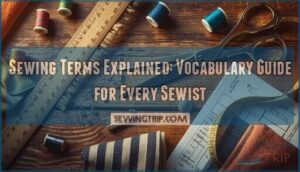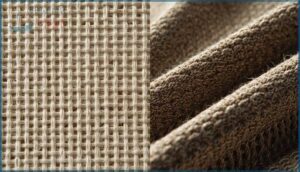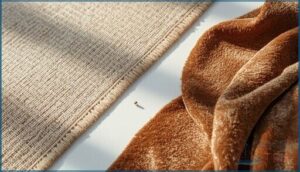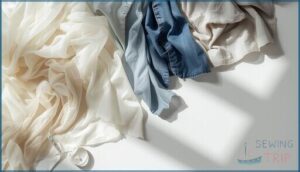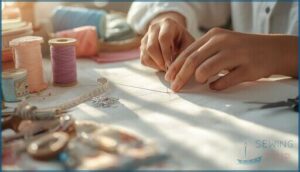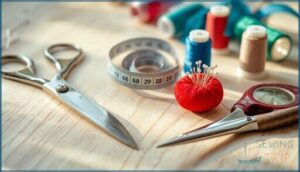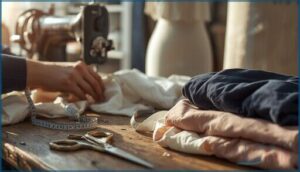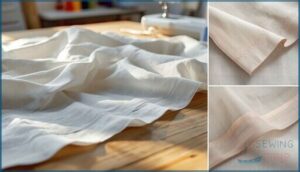This site is supported by our readers. We may earn a commission, at no cost to you, if you purchase through links.
You pull out a pattern and the instructions might as well be written in code. Terms like “selvage,” “grainline,” and “seam allowance” appear without definition. You’re left guessing whether a dart is something you throw or something you sew. This confusion stops many beginners before they finish their first project.
Sewing vocabulary isn’t decorative language—it’s the foundation that turns printed instructions into wearable garments. Once you understand what each term means, patterns become readable maps instead of cryptic puzzles.
The difference between a fabric’s grain and its nap affects how your finished piece looks and fits.
Table Of Contents
- Key Takeaways
- Essential Sewing Vocabulary for Beginners
- Fabric Types and Their Terminology
- Basic Sewing Techniques Defined
- Sewing Tools and Equipment Terms
- Garment Construction Vocabulary
- Pattern Markings and Instructions
- Embellishments and Decorative Terms
- Common Fabric Finishing Terms
- Sewing Notions and Supplies Explained
- A-Z Glossary of Sewing Terms
- Frequently Asked Questions (FAQs)
- Conclusion
Key Takeaways
- Sewing vocabulary transforms confusing pattern instructions into clear construction steps by defining essential terms like seam allowance, grainline, selvage, and dart that directly affect garment fit and appearance.
- Understanding fabric structure—woven versus knit, grain direction, and weight categories—determines which materials work for specific projects and prevents common construction mistakes.
- Core techniques like basting, backstitch, topstitching, and proper seam finishing create the difference between amateur-looking and professional-quality garments.
- Mastering pattern markings such as notches, dots, and grainlines combined with knowing your tools turns flat fabric into precisely fitted clothing that matches your vision.
Essential Sewing Vocabulary for Beginners
Learning to sew means picking up a new language along the way. You’ll come across terms that sound unfamiliar at first, but they quickly become second nature once you start using them.
The words below will give you the foundation you need to follow patterns, understand tutorials, and feel confident as you build your skills.
Common Sewing Terms Explained
Seam Basics anchor your sewing practice. You’ll encounter terms like seam allowance—the distance from the raw edge to the stitching line—and basting, a temporary stitch holding fabric before final construction. Fabric texture describes the surface feel, while stitch types range from running to backstitching. Here’s your foundation:
- Seam: where two fabric pieces join through stitching
- Topstitching: visible stitching on the garment exterior
- Selvage: factory-finished fabric edge preventing fraying
- Grainline: fabric’s lengthwise thread direction guiding pattern placement
Must-Know Words for New Sewists
You’ll master your sewing fundamentals faster when you know these beginner vocabulary essentials. Start with fabric terms like drape and grain, then build your sewing glossary with core sewing techniques—gathering, darning, and interfacing.
These sewing basics form your foundation. Focus on practical sewing terms you’ll encounter in every project: dart, yoke, backstitch, and seam ripper.
Each word unlocks new creative possibilities for beginners.
Understanding Pattern Instructions
Pattern instructions turn cryptic symbols into clear garment construction steps. You’ll decode notch usage marks that align fabric edges and grainline arrows that guide cutting layouts.
Pattern labeling identifies each piece by number or letter. Seam allowance measurements appear along edges—usually ⅝ inch.
Instruction decoding becomes second nature once you understand these sewing terms connect paper patterns to finished projects.
Fabric Types and Their Terminology
Understanding fabric terminology is the foundation for every sewing project you’ll tackle. The way fabric is made and how it behaves will determine what you can create with it.
Let’s break down the essential fabric terms you need to know before you cut your first piece.
Woven Vs. Knit Fabrics
You’ll encounter two fundamental fabric structures in sewing: woven fabric and knits. Woven fabrics form from interlacing yarn types on a loom, creating a stable grid with minimal stretch except along the bias. Knits loop yarn together, producing stretchy, flexible material.
Understanding fabric structure helps you choose the right textile for your project and adjust techniques accordingly.
Grain, Nap, and Selvage
Fabric grain describes the direction of threads in woven fabric, running parallel and perpendicular to the selvage edge. Proper grain alignment prevents fabric distortion and ensures your garment hangs correctly.
Nap refers to a directional surface texture on fabrics like velvet, affecting appearance and requiring consistent nap orientation when cutting.
The selvage is the finished factory edge that prevents unraveling and acts as your grainline reference point.
Fabric Weights and Drape
Weight classes determine how your textile behaves and falls. Fabric density affects drape analysis, fiber orientation, and fabric stiffness in every project you tackle.
Choose interfacing that complements your fabric’s natural characteristics.
- Light fabrics (up to 180 g/m²) create flowing silhouettes with soft drape
- Medium weights (180-350 g/m²) offer moderate body and structure
- Heavy textiles (over 350 g/m²) provide firm drape for structured garments
- Grain and weaving influence drape beyond weight alone
Basic Sewing Techniques Defined
Mastering basic techniques is where sewing starts to feel like second nature. You’ll use these methods in nearly every project you make.
Let’s break down the core techniques every sewist needs to know.
Seams and Seam Allowance
A seam is where two fabric pieces join through stitching. Seam allowance is the fabric distance from the raw edge to your stitching line. Standard measurements are ¼ inch, ½ inch, or ⅝ inch. Understanding these sewing terms helps you follow patterns accurately and adjust fit during alterations.
| Measurement | Common Use | Precision Level |
|---|---|---|
| ¼ inch (6mm) | Quilting, lightweight fabrics | High precision required |
| ½ inch (12mm) | General garments, medium weight | Moderate flexibility |
| ⅝ inch (1.5cm) | Standard patterns, wovens | Industry standard |
| Variable | Bias cuts, grainline considerations | Fabric-dependent |
Seam construction affects how your garment fits and wears. Wider allowances give you room for adjustments while narrower ones reduce bulk. Seam finishing prevents fraying and adds durability. Consider fabric shrinkage before cutting and always match your seam reinforcement to the fabric weight for professional results.
Basting, Backstitch, and Gathering
These three fundamental sewing terms define how you control fabric during construction. Basting uses long temporary stitches to hold layers before final seams. Backstitch creates secure starting and ending points by sewing forward and backward. Gathering draws fabric into soft folds using evenly spaced basting stitches.
Mastering stitch tension and fabric handling with these techniques ensures professional results across all your projects.
Topstitching and Understitching
You’ll encounter these two sewing terms when creating polished edges. Topstitching places visible stitches on the garment exterior, reinforcing seams while adding decorative detail. Understitching hides within facings, preventing them from rolling outward.
Both require proper stitch length and thread tension for clean results. Edgestitching sits close to seam lines, while top stitch placement varies based on fabric choice and your desired edge finishing effect.
Sewing Tools and Equipment Terms
You can’t sew without the right tools in your hands. Each piece of equipment has its own name and purpose in your workspace.
Let’s break down the essential tools you’ll use from your first stitch to your hundredth project.
Sewing Machine Parts
Your sewing machine isn’t just a box with buttons—it’s a symphony of moving parts working in harmony. The presser foot holds fabric steady while feed dogs pull it through. The needle bar drives the needle up and down as the bobbin case interlocks threads below.
Understanding tension discs, machine feet, and these core components turns confusion into confidence at your workstation.
Hand Sewing Tools
Your toolkit extends beyond machines into hand tools that shape your needlework. Thimble types protect fingers during detailed stitching—metal, leather, or silicone finger guards each serve different fabrics. Pin cushions keep straight pins organized while needle threaders simplify threading fine needles. A sewing awl pierces heavy materials like leather.
These sewing notions transform frustrating moments in your sewing circle into smooth, confident handwork you’ll actually enjoy.
Cutting and Measuring Tools
Accurate fabric cutting starts with sharp rotary cutters that slice multiple layers on self-healing cutting mats. Pinking shears prevent fraying with zigzag edges. Measuring tapes and sewing rulers guarantee precise seam allowances while fabric markers transfer notch symbols from patterns.
These sewing tools transform guesswork into exact fabric cutting—your finished garment reflects every measurement you make before weaving thread through cloth.
Garment Construction Vocabulary
Garment construction vocabulary covers the structural elements that give your projects their shape and finish. These terms describe how fabric is manipulated to create fitted silhouettes and polished edges.
Understanding these building blocks helps you follow patterns with confidence and troubleshoot fit issues as they arise.
Dart, Yoke, and Placket
You’ll master garment shaping through three essential construction elements. A dart is a stitched fold that cinches fabric to contour the bust or waist. Yoke patterns anchor the shoulders and distribute fullness below. Placket designs finish openings at necklines or front seams with clean, interfaced edges.
These sewing techniques transform flat fabric into garments that fit your body’s natural curves.
Facing, Lining, and Interfacing
To give your garment polish and structure, you’ll need three essential layers: facing, lining, and interfacing. Facing techniques finish raw edges at necklines and armholes with a clean fold, while lining methods add a smooth interior layer that hides seam notions. Interfacing types reinforce collars and waistbands, providing garment stability through fusible or sew-in options.
- Facing creates finished edges without visible stitching on the right side
- Lining conceals interior seams and adds comfort against your skin
- Interfacing prevents stretching in high-stress areas like buttonholes
- Choose fusible interfacing for quick heat-activated bonding to fabric
- Combine all three elements for professional sewing finishes that last
Boning and Stay Stitching
Structured garments rely on two key techniques to stabilize fabric during construction and wear. Boning types include flexible plastic for bodices and steel bones for corsetry, maintaining shape without restricting movement.
A stay stitch runs inside the seam allowance at curved edges like necklines, preventing stretching before joining pieces. Both techniques work with interfacing to create garment construction that holds its form beautifully through years of use.
Pattern Markings and Instructions
Pattern markings are the secret language printed on your tissue pattern pieces. They guide you through cutting, alignment, and assembly with precision.
Understanding these symbols transforms confusing squiggles into clear instructions that make sewing smoother and more accurate.
Notches, Dots, and Grainlines
Think of notches, dots, and grainlines as your roadmap to professional seam accuracy.
Notches are small triangular marks that guarantee proper notch placement when joining fabric pieces. Dots signal vital alignment points for features like darts or pockets.
Grainlines guide fabric orientation by running parallel to the selvage, maintaining correct grain and preventing your pattern from twisting or warping during construction.
Cutting Lines and Seam Symbols
Understanding cutting lines and seam symbols transforms pattern markings into sewing accuracy you can trust. These guides show where your fabric layout meets cutting techniques, ensuring proper seam allowances from selvage to finished edge.
Key pattern markings to recognize:
- Solid cutting lines – Outline each pattern piece along the grain for precise fabric cuts
- Dashed seam extensions – Mark standard seam allowances beyond the cutting line
- Alignment notches – Triangle or diamond shapes that guarantee accurate piece-to-piece matching during construction
Pattern Adjustment Terms
Pattern alteration modifies your base design to match specific body measurements through fit adjustments. You’ll encounter dart manipulation to reposition shaping, seam shaping along curves, and grainline correction to preserve fabric orientation.
Common changes include lengthening at the bust or waist, adjusting ease for comfort, and redrawing notch locations. Always mark your alterations and test with muslin before cutting final fabric.
Embellishments and Decorative Terms
Embellishments transform plain fabric into something special. These decorative techniques add texture, visual interest, and personality to your projects.
Understanding these terms helps you choose the right finishing touches for your garments and crafts.
Appliqué, Embroidery, and Quilting
You’ll transform fabric with three standout techniques that add depth and artistry. Applique attaches fabric shapes using visible or hidden stitches—fusible applique uses heat-activated webbing for quick bonding.
Embroidery employs decorative threads and embroidery stitches like satin stitch or French knots, guided by embroidery patterns.
Quilting stitches three layers together using quilting patterns, with batting materials providing warmth and structure between your top fabric and backing.
Ruffles, Piping, and Trims
You’ll enhance garments with fabric embellishments that define edges and add movement. Ruffle techniques gather fabric into wavy fullness using longer stitches. Piping methods insert bias-cut cording into seams for structural definition. Trim applications attach lace, ribbons, or tassels using edgestitch or zigzag seams.
- Ruffles create volume through gathering ratios that control fullness
- Piping provides raised definition along curved or straight seams
- Trims finish edges with decorative materials affecting drape and weight
Binding and Contrast
Binding techniques wrap fabric strips around raw edges for clean edge finishing on necklines, armholes, and quilts. Bias binding cuts fabric on the diagonal grain, allowing flexibility around curved seams without puckering.
Contrast edges use different fabric colors to highlight binding and create visual interest along seams. You’ll apply binding by folding strips over raw edges and stitching through all layers.
Common Fabric Finishing Terms
Finishing techniques give your sewing projects a polished and professional appearance. These terms describe how you complete raw edges and prepare fabric surfaces throughout construction.
Understanding these basics helps you choose the right method for each project you tackle.
Hemming and Edge Finishes
You’ll encounter two main approaches when finishing fabric edges: hemming techniques that fold and secure the raw edge, and edge finishes that protect against fraying.
A blind hem hides stitches from the right side, while decorative stitching showcases your seam work. For knits, try twin-needle hems to preserve stretch.
Each finish transforms your raw edge into a polished, professional result.
Seam Finishes and Serging
Seam finishing protects fabric edges from fraying after you’ve sewn a seam. Serging uses an overlock machine to trim and stitch edges simultaneously with three or four threads. French seams encase raw edges within a double fold, ideal for sheer fabrics.
Your serger’s differential feed prevents puckering on knits, while rolled hems create delicate finishes on lightweight materials.
Pressing and Ironing Vocabulary
After finishing your seams, you’ll shape fabric with proper pressing techniques. Pressing differs from ironing—you lift and lower the iron without sliding. Steam settings relax fibers while grain alignment prevents distortion. Your pressing tools include:
- Tailor’s ham for curved seams
- Seam roll for narrow edges
- Pressing cloth for delicate fabric
- Dry iron for interfacing
- Presser foot for precision work
Iron maintenance prevents fabric damage.
Sewing Notions and Supplies Explained
You can’t sew without the right supplies in your toolkit. Notions are the small but essential items that bring your projects to life.
Here are the key supplies every sewist needs to understand and keep on hand.
Thread, Bobbins, and Needles
Selecting the right thread types, bobbin sizes, and needles transforms your sewing from frustrating to impeccable. Cotton thread works beautifully with natural fibers, while polyester thread offers strength for knits. Your bobbin must match your machine’s specifications—metal bobbins provide consistent thread tension. Needle selection depends on fabric weight: ballpoint needles prevent laddering in knits, while universal needles handle most wovens.
| Sewing Notion | Key Types | Primary Uses |
|---|---|---|
| Thread | Cotton, Polyester, Silk | Natural fibers, knits, delicates |
| Bobbin | Metal, Plastic, Pre-wound | Machine-specific tension control |
| Needle | Ballpoint, Universal, Sharp | Knits, general sewing, tight weaves |
| Thread Tension | Upper, Bobbin, Balanced | Prevents looping and puckering |
Buttons, Zippers, and Fasteners
Understanding closure methods elevates your garment finishing skills from basic to polished. Button placement determines garment drape and functionality, while zipper types range from invisible to exposed metal. Snap fasteners provide quick closures for children’s wear, and hooks and eyes secure waistbands invisibly.
- Flat buttons have holes for thread attachment through the fabric surface.
- Shank buttons contain a loop underneath for thick fabrics and coats.
- Invisible zippers hide completely within seams for professional finishes.
- Coil zippers use flexible plastic teeth for curved applications and bags.
- Hook-and-eye closures fasten waistbands and necklines where buttons would gap.
Interfacing and Stabilizers
Fusible Interfacing and Sewing Stabilizers are essential notions that provide fabric support, transforming flimsy materials into professional garments with crisp edges and stable seam lines. Fusible Interfacing bonds to fabric with heat-activated adhesive, adding body and structure, while Sewing Stabilizers prevent distortion during embroidery and decorative stitching.
Interfacing Weights range from lightweight for collars to heavy for belts, catering to various garment needs. Stabilizer Types include tear-away, cut-away, and wash-away options, each serving specific purposes in sewing projects.
| Interfacing Type | Best Use |
|---|---|
| Fusible Lightweight | Collars, facings |
| Fusible Medium | Cuffs, waistbands |
| Sew-In Interfacing | Delicate fabrics |
| Tear-Away Stabilizer | Embroidery projects |
Both notions play a crucial role in achieving professional results, ensuring that garments maintain their shape and structure over time.
A-Z Glossary of Sewing Terms
You’ve covered the essentials, and now it’s time to pull everything together in one place.
This glossary gives you quick access to sewing terms from A to Z, so you can look up any word you encounter.
Use it as your reference guide whenever you’re reading patterns, following tutorials, or expanding your skills.
A-E Sewing Vocabulary
Your sewing vocabulary begins here with the foundation letters. These Sewing Terms decipher pattern instructions and build your confidence at the machine. Master this Glossary of essential Sewing Terminology:
- A-line – A dress silhouette widening gradually from shoulder to hem
- Alignment Guide – Matching fabric edges and notches before stitching
- Applique Art – Decorative fabric shapes sewn onto background fabric
- Armscye – The armhole opening where sleeves attach
- Backstitch Tips – Reinforcement stitches securing seam ends
Edge Finishing and Seam Basics start with understanding Applique techniques.
F-J Sewing Vocabulary
Your next vocabulary tier moves from foundation to function. These terms cover fabric grain direction, facing techniques, and finishing seams that transform raw edges into professional results.
| Term | Definition | Usage |
|---|---|---|
| Facing | Fabric piece finishing garment openings | Necklines and armholes |
| French Seam | Enclosed seam hiding raw edges | Sheer fabrics |
| Fusible Interfacing | Heat-activated stabilizing material | Collars and cuffs |
Gathering creates controlled fullness through folding methods. Fabric stretch determines your finish approach.
K-O Sewing Vocabulary
Knit fabric terms reveal stretch materials that behave differently than wovens. You’ll master these K-O essentials as your project range expands beyond basic seams.
- Knit fabric terms: Jersey and rib knit describe loop-based structures with 20-60% stretch percentage
- Overcast stitches: Finishing method preventing raw edge fraying
- Oriented grain: Fabric direction alignment for pattern pieces
- Ladder stitch: Invisible hand-sewing technique for closures
- Notions: Small sewing supplies including buttons and zippers
P-Z Sewing Vocabulary
Your sewing language grows complete when you master P through Z terminology. These final terms include Piping techniques for decorative edges, Zipper installation methods, and specialized concepts like Pintucks and Ruching. Pattern zoning guides fabric placement while Quilting joins layers with decorative stitching. Understanding Raw Edge versus Right Side orientation prevents assembly mistakes.
| Term | Definition | Common Use |
|---|---|---|
| Piping techniques | Inserting fabric-covered cord into seams | Decorative edges on cushions and garments |
| Puddle stitching | Invisible hand-sewing method for hems | Finishing formal wear and drapery |
| Zonal fabrics | Textiles with distinct color regions | Directional pattern layouts |
| Zipper installation | Methods for inserting slide fasteners | Exposed, invisible, or centered applications |
Frequently Asked Questions (FAQs)
What do you need to know about sewing terminology?
Understanding core sewing terminology transforms pattern instructions from confusing puzzles into clear roadmaps.
You’ll decode fabric properties, master construction methods, recognize garment parts, identify essential tools, and confidently navigate any sewing glossary designed for beginners learning foundational techniques.
What is a sewing Dictionary for beginners?
A reference book defines common fabric, tool, and technique terms used in patterns and tutorials.
You’ll decode instructions faster and join the sewing community with confidence when you understand this beginner-friendly glossary.
What does sew mean in sewing?
Sew” simply means joining fabric layers with thread and needle. You’ll use this basic action to create seams, attach trims, and construct garments through hand stitching or machine sewing techniques.
What is the a to Z of sewing terminology?
The A-to-Z glossary covers sewing basics like seam, stitch, pattern, and grainline through hem and yoke.
Each term defines fabric texture, garment construction, or sewing techniques you’ll encounter in every project.
What Are Some Good Entry-level Sewing Machines for Beginners?
Your maiden voyage into sewing deserves a solid partner. Brother CS and Singer Simple models offer beginner-friendly features like automatic needle threaders and 50-plus stitches, usually priced between $100 and $
How Do I Choose Fabric for Different Types of Garments and Seasons?
Match fabric weight to garment types: lightweight cottons for blouses, medium-weight knits for casual wear, heavyweight wools for coats. Choose breathable natural fibers for summer, insulating materials for winter garments.
What Supplies Do I Need to Get Started With Sewing?
Building your toolkit is like gathering ingredients before cooking your first meal. You’ll need a sewing machine, universal needles, sharp fabric scissors, pins, thread, measuring tape, and medium-weight cotton fabric to start confidently.
How do I adjust sewing machine tension?
Your sewing machine’s tension dial controls the upper thread. Turn it to a lower number if loops appear on top, or higher if they show underneath. Test on scrap fabric after each adjustment.
What is a seam allowance, and why is it important?
A seam allowance is the fabric border beyond the stitching line, usually 0–5 cm.
It ensures proper garment construction, allows seam finishing, prevents puckering, and provides room for future alterations without compromising fabric grain or sewing accuracy.
How can I choose the right sewing needle?
You choose the right sewing needle by identifying your fabric type first, then matching needle size to fabric weight and thread weight, testing on scrap material before final stitching.
Conclusion
What separates a confident sewist from a frustrated beginner? It’s not talent—it’s understanding the language. With these sewing terms explained, you’ve gained vocabulary that transforms patterns from puzzles into precise instructions.
Each word you’ve learned unlocks clearer construction, better fabric choices, and smoother projects. You now speak the language of sewing. That knowledge doesn’t just help you follow directions—it helps you see possibilities in every piece of fabric you touch.

